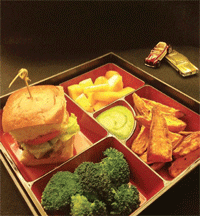 UNLESS YOU'RE MIKE VUICK, the Monroeville, PA, restaurant owner who drew much flak after banning children under six from the premises last summer, you probably want to see kids eating in your restaurant. And you want parents to be happy about the choices you offer their offspring. A two-pronged approach combining food and fun seems to be the most effective way to reach both audiences.
UNLESS YOU'RE MIKE VUICK, the Monroeville, PA, restaurant owner who drew much flak after banning children under six from the premises last summer, you probably want to see kids eating in your restaurant. And you want parents to be happy about the choices you offer their offspring. A two-pronged approach combining food and fun seems to be the most effective way to reach both audiences.
Any discussion of feeding kids today starts with health considerations. The National Restaurant Association underscored concerns about kids' diets last year when it rolled out the Kids LiveWell campaign. Restaurants participating in the voluntary program commit to offering healthful meal items for children, with a particular focus on increasing consumption of fruit and vegetables, lean protein, whole grains and low-fat dairy, and limiting unhealthy fats, sugars and sodium. Some 15,000 restaurant locations pledged to follow the guidelines when they were rolled out. That commitment won them some coverage on healthydiningfinder.com.
The association has taken things a step further by launching a Healthier Kids Fare pavilion at the upcoming NRA Show. The pavilion will feature nutritious items from food and beverage manufacturers, including products with lower fat, sugar and sodium.
This is no longer a matter of adults forcing kids to eat their vegetables, either. According to NPD's CREST service, which tracks consumer usage of restaurants, “the continuing pressure on restaurant operators to improve the healthfulness of kids meals combined with increasing health consciousness among moms has resulted in children, younger than 13, eating more better-for-you foods like fruit, nonfried chicken, chicken wraps, cereal; and less of the not-so-good-for-you foods, like French fries, dessert items/frozen sweets, regular size burgers and fried chicken.”
Chevys Fresh Mex, one of the chains participating in Kids LiveWell, offers choices such as a soft chicken taco with carrots and celery and sweet corn tamalito, served with pineapple juice; or a soft picadillo beef taco with grilled veggies, carrots and celery sticks and apple juice.
Small changes like this mean a lot when it comes to children's meals. By switching from fried chicken nuggets to grilled chicken nuggets, for instance, Chick-fil-A slashed calories and fat in kids' meals by more than half. The quick-service brand is also promoting milk, apple juice, lemonade and water as choices for children.
Movenpick Hotels & Resorts recently rolled out a new Power Bites menu at selected locations; the low-fat, reduced-sodium recipes incorporate a variety of produce. To make them appealing to kids, meals create characters and scenes using the food as props: a millipede with a tomato head inches across a plate on cucumber feet, while a tiny farm girl rakes spaghetti from a tube.
“Food should be fun and if it's nutritious, so much the better,” says Peter Drescher, a regional v.p. of food & beverage for Movenpick. “We invite children to eat with their fingers, paint carrots, arrange little characters. It's important that restaurants become welcoming places for children and that they enjoy themselves. Families go out to eat to have fun. We're just here to help.”
A rebranding of the 49-unit Fatz chain introduced a kids' meal program featuring VeggieTales, a series of talking vegetables. Among choices are a variety of healthy options. The program includes activity books and a coloring contest tied into the VeggieTales theme.
Y-Pulse, a research and consulting firm, found “a very gradual movement by kids to embrace vegetables and fruits as larger parts of their diets,” says Sharon Olson, cofounder. “But there are still old standbys that top their lists of favorite foods, and often what they say they want is not what they choose.” More than half of kids say they opt for chicken and pizza one or two times a week at school lunches, but Y-Pulse found that more kids say they like vegetables and want to try new global or ethnic foods.
SushiSamba has capitalized on that interest with its SambaKids menu, which includes bento box meals, samba sliders served with sweet potato fries, anticuchos and sushi bites — small nigiri served with a veggie roll. Mocktails for kids include a Watermelon Mojo and Berry Fiz. Guests under 12 eat free all day from the menu.
Not only are more kids open to ethnic food, many of them are eating more like adults, especially at upscale restaurants.
Sarah Stegner, chef/owner at two Prairie Grass restaurants in the Chicago area, menus a grass-fed 4-ounce tenderloin with a vegetable for $21.50 and recently reported that it is one of the most popular meals for kids. Stegner, one in a group of operators in the Windy City that has committed to offering at least one nutritionally sound meal option for kids, also serves a chicken cutlet with carrots for $6 and whitefish fillet with seasonal vegetable for $10.
Landmarc and Ditch Plains, Marc Murphy's two New York concepts, offer everything from a $17 petite filet to a $7 peanut butter and Nutella sandwich, alongside amusing choices like green eggs and ham ($7). Murphy's restaurants also include a recently added box on the menu spotlighting meals that adhere to the dietary guidelines introduced by Michelle Obama and the USDA last year. “This new initiative just eases the process of ordering balanced meals for your kids,” Murphy explains. The Fun Factor
The Fun Factor
Healthy options and kid-friendly foods are a start, but family dining is about more than just sustenance. Parents and kids have different interests and needs at mealtime, and a number of operators have figured out how to satisfy both audiences.
The Seaport Hotel in Boston, for example, hosts a Fine Dining Family Style event at its Aura restaurant. The evening includes two separate fixed menus that change every month and entertainment for the younger audience such as crafts, toys and a movie. Children's meals (e.g., grilled chicken breast, lo mein noodles, snap peas and steamed broccoli, cookies) are served in bento boxes. Adult meals run $30, while the bento box selections are $14; infants' meals run $3. About 60-75 guests attend the events each month.
At the New York Burger Company in New York, a Sunday Magic Lunch features a popular local magician and a deal for children that includes miniburgers, a small order of Idaho or sweet potato fries and a fountain soda or spring water starting at $6.50. Similar full-size meals for adults are available for $10.75 and up.
Some restaurants go the D-I-Y route to keep their young customers entertained. Libertad, which opened last fall in suburban Chicago, hosts Sunday night make-your-own quesadillas, pasta, grilled cheese, taquitos and so on. At a recent event, customers 10 and younger built quesadillas using flour tortillas, cheese, chicken, mushrooms, tomatoes and other vegetables; chef-partner Armando Gonzales grilled the resulting creations. Kids eat free, while parents are asked to donate to the restaurant's designated charity, which changes regularly.
SushiSamba offers classes for kids: One shows them how to make their own sushi using favorite ingredients, while the other teaches them capoeira, a Brazilian fusion of dance and martial arts.
Arguably the most ambitious approach to family dining comes from newcomer Giggles ‘N’ Hugs. With one unit open in Los Angeles and aggressive plans to expand, the concept is a children's themed restaurant with built-in play areas filled with a variety of toys, bikes, cars, slides, doll houses and video games, along with daily live entertainment and shows. Menu choices incorporate organic ingredients and, for an additional cost, health-halo items like pureed vegetables and flaxseeds are folded into the dishes to provide a hidden nutritional boost. Targeting a more affluent demographic, Giggles ‘N’ Hugs' management is eyeing upscale shopping centers for future development.
Two Key Niches: Teens/Tweens & Latinos
TWO SUBSETS of the kids/family market may merit different approaches.
It's no surprise to anyone who lives with TEENS or TWEENS, but they wield considerable veto power when it comes to dining out. According to Technomic, about half of both groups say their families decide together which full-service restaurant to patronize. And with peer pressure bearing down, they also influence where their friends eat.
They also can't be lumped together, says Ian Davidson, senior manager of brand insights at C3, a brand marketing agency that partnered with Technomic on a report. “Today's tweens and teens are a diverse population, even within demographic and age segments,” he says. “They can often be difficult for marketers to understand and engage. Brands that are successful with tweens and teens will need to demonstrate a tiered strategy to reach this powerful group of consumers.”
Teens may be suffering from fast-food or brand burnout. They are most likely drawn to new, exciting restaurant concepts.
As they mature, children may snack less but eat larger quantities of food.
One-size-fits-all won't work for kids, tweens and teens. Operators should consider tailoring menu offerings and marketing strategies to fit various stages.
ANOTHER GROUP that might demand a slightly different approach is Hispanics. An NPD Crest report found that more than 40 percent of restaurant visits by Hispanic customers include children; typically, non-Hispanic customers bring children along 30 percent of the time. Spanish-language dominant Hispanics are the most likely to include children in their foodservice visits.
The implications are twofold.
“Hispanic restaurant consumers tell us that they would visit restaurants more if they make children feel welcome. Language also matters in reaching this market,” says Michele Schmal, v.p. of product management for NPD's foodservice unit. “Restaurant operators and food manufacturers would do well to focus marketing to Hispanics around the family and children.” What meals qualify for the Kids LiveWell program?
What meals qualify for the Kids LiveWell program?
Complete meals must be:
600 calories or less
≤ 35% of calories from total fat
≤ 10% of calories from saturated fat
< 0.5 grams trans fat (artificial trans fat only)
≤ 35% of calories from total sugars (added and naturally occurring)
≤ 770 mg of sodium
2 or more food groups (see below)
Side items must be:
200 calories or less
≤ 35% of calories from total fat
≤ 10% of calories from saturated fat
< 0.5 grams trans fat (artificial trans fat only)
≤ 35% of calories from total sugars (added and naturally occurring)
≤ 250 mg of sodium
1 food group (see below)
Full meals must include two sources and sides must include one source of the following:
Fruit: ≥ ½ cup = 1 star (includes 100% juice)
Vegetable: ≥ ½ cup = 1 star
Whole grains: contains whole grains = 1 star
Lean protein (skinless white meat poultry, fish/seafood, beef, pork, tofu, beans, egg): ≥ 2 ounces meat, 1 egg or egg equivalent, 1 oz nuts/seeds/dry bean/peas = 1 star (lean as defined by USDA)
Lower-fat dairy (1% or skim milk and dairy): ≥ ½ cup = 1 star (while not considered low-fat, 2% milk is allowed if included in the meal and the meal still fits the full meal criteria)

Feeding Kids: The New Rules
Looking to ramp up business from families? The menu is important, sure — but it's more than just food.
0 comments
Hide comments




